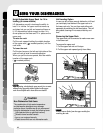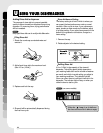
TT
RROOUUBBLLEESSHHOOOOTTIINNGG
18
TROUBLESHOOTING
If you can’t fix problems with the above actions or you have different problems which are not mentioned in the manual,
please call LGE Customer Service at 1-800-243-0000.
Problem Causes Recommended Actions
Check the door is completely closed and latched.
Select the desired cycle.
Connect power supply properly.
Check water faucet.
Replace fuse or reset circuit breaker.
Check hot water faucet is connected (Heating water takes it longer).
Operate Quick Wash cycle with detergents without loading dishes.
Straight hose.
Select right cycle based on dish types and soil toughness.
Use hot water faucet.
Use recommended detergents.
Water pressure should range between 20 ~ 120psi.
Clean the arm.
Dishes shouldn’ t interrupt arm rotation and detergent dispensing.
Supplied water temperature should be 120 for the best washing performance.
Use the recommended amount of detergent.
Load the proper amount of dishes.
Rearrange dish loading referring to photo at page 10 & 11.
Adjust water pressure between 20 and 120 psi.
Add the recommeded amount of detergent referring to detergent instructions.
Refill the Rinse aid dispenser.
Install home water softener.
Detergent cover opening.
Drainage Sound at the early stage.
Reposition your dishwasher.
Reposition your dishes.
Underload the dishwasher and use a rinse aid to minimize this process.
Remove aluminum markings with a mild cleaner.
Eliminate the soil by using a stain removal product.
Check and refill the rinse agent if empty.
Connect power supply.
Replace fuse and repair circuit breaker.
Clean the holes of the spray arms.
Adjust the upper rack properly referring to page 12.
Check clogging of water inlet hose (or hose twist or freezing).
Check water supply.
Check clogging of water drain hose (or twist or freezing).
Please call your Authorized Service Center or
LGE Customer Service at 1-800-243-0000.
Door is not completely closed.
Cycle is not selected.
Power supply is not connected.
Water is not supplied.
Fuse is blown out.
Cold water is supplied.
Remaining water inside from the last cycle
Drain hose is bent or clogged.
Improper cycle selection
Water temperature is low.
Dishwashing detergent was not used.
Low inlet water pressure
Water jet holes of spray arms blocked.
Improper dish loading
Low water temperature
Proper detergent amount used
Overloading
Improper loading
Insufficient water pressure
Insufficient detergent
Rinse aid dispenser empty.
Extremly hard water
This is normal.
Your Dishwasher isn’t horizontal.
Nozzle arm knocks against the dishes.
Combination of excessive detergent and soft water
Aluminum items rub dishes during cycle.
Coffee or tea soils
Rinse agent dispenser empty.
Power is not connected.
Fuse is blown out or circuit breaker is tripped.
The holes of spray arms is blocked by food particles.
Rack is poorly adjusted.
Water inlet trouble
Drainage trouble
Excessive water supplied
Water leakage trouble
Heater Circuit Failure
Thermistor trouble or very high inlet water
temperature. (over 194
)
Dishwasher does not operate
Too long operation
Odor
Water remains after a cycle finishes
Food Soil remains on dishes
Spots and filming on dishes
Noise
Cloudiness on glassware
Black or gray marks on dishes
Yellow or brown film on inside surfaces
Dishes don’t dry
The lamps don’t illuminate
Spray arms don’t rotate smoothly
Upper rack crooked after loading
IE Error
OE Error
FE Error
E1 Error
HE Error
TE Error


















